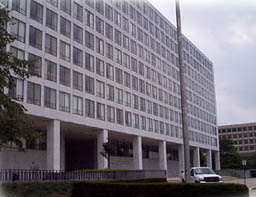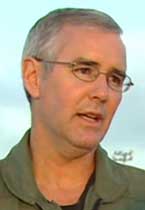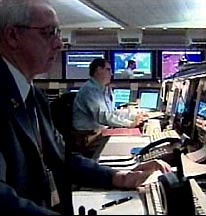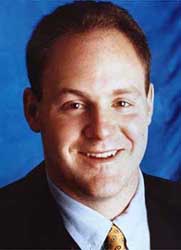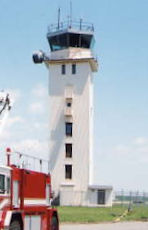Michael Woodward, a manager at the American Airlines flight services office at Logan International Airport in Boston, instructs a colleague to find out the details of three hijackers on Flight 11, based on their seat numbers, but it is unclear whether his colleague is then able to identify the hijackers. [ABC News, 7/18/2002; New York Observer, 2/15/2004]
Since 8:32 a.m., Woodward has been on the phone with Amy Sweeney, a flight attendant on Flight 11, who has been describing to him the trouble on her plane (see (8:32 a.m.-8:44 a.m.) September 11, 2001). [9/11 Commission, 8/26/2004, pp. 11]
During the call, she says that the men who hijacked her plane were in seats 9D, 9G, and 10B. [9/11 Commission, 1/25/2004 pdf file] According to the New York Observer, Woodward then orders a colleague "to punch up those seat locations on the computer." [New York Observer, 2/15/2004]
This enables airline personnel "to pull up [the hijackers'] names, phone numbers, addresses—and even credit card numbers—on the reservations computer," according to ABC News. ABC News will add, "One of the names that came up was Mohamed Atta," the name of the lead hijacker. [ABC News, 7/18/2002]
However, apart from 10B—the number of the seat belonging to Satam Al Suqami—the seat numbers provided by Sweeney are different to the numbers of the seats assigned to the hijackers. The five hijackers on Flight 11 were in seats 2A, 2B, 8D, 8G, and 10B, according to the 9/11 Commission Report. Atta was in seat 8D—not one of the seats mentioned by Sweeney. [Los Angeles Times, 9/20/2001; 9/11 Commission, 7/24/2004, pp. 2]
It is therefore unclear whether American Airlines is able to determine the identities of any of the hijackers, other than, presumably, Al Suqami, at this time. Evelyn Nunez, a passenger service agent at the American Airlines flight services office, was provided with the seat number of Al Suqami, but none of the other hijackers, when she talked with Sweeney in an earlier call, at 8:25 a.m. (see 8:25 a.m. September 11, 2001). By running a computer check, she was able to determine Al Suqami's identity from this number. [Federal Bureau of Investigation, 9/11/2001, pp. 57-58]
Nancy Wyatt, another employee in the flight services office, will pass on the three hijackers' seat numbers provided by Sweeney to the American Airlines System Operations Control center in Fort Worth, Texas, when she calls it at 8:40 a.m. (see 8:40 a.m.-8:48 a.m. September 11, 2001). [American Airlines, 9/11/2001, pp. 34-41; 9/11 Commission, 8/26/2004, pp. 14]
Since 8:32 a.m., Woodward has been on the phone with Amy Sweeney, a flight attendant on Flight 11, who has been describing to him the trouble on her plane (see (8:32 a.m.-8:44 a.m.) September 11, 2001). [9/11 Commission, 8/26/2004, pp. 11]
During the call, she says that the men who hijacked her plane were in seats 9D, 9G, and 10B. [9/11 Commission, 1/25/2004 pdf file] According to the New York Observer, Woodward then orders a colleague "to punch up those seat locations on the computer." [New York Observer, 2/15/2004]
This enables airline personnel "to pull up [the hijackers'] names, phone numbers, addresses—and even credit card numbers—on the reservations computer," according to ABC News. ABC News will add, "One of the names that came up was Mohamed Atta," the name of the lead hijacker. [ABC News, 7/18/2002]
However, apart from 10B—the number of the seat belonging to Satam Al Suqami—the seat numbers provided by Sweeney are different to the numbers of the seats assigned to the hijackers. The five hijackers on Flight 11 were in seats 2A, 2B, 8D, 8G, and 10B, according to the 9/11 Commission Report. Atta was in seat 8D—not one of the seats mentioned by Sweeney. [Los Angeles Times, 9/20/2001; 9/11 Commission, 7/24/2004, pp. 2]
It is therefore unclear whether American Airlines is able to determine the identities of any of the hijackers, other than, presumably, Al Suqami, at this time. Evelyn Nunez, a passenger service agent at the American Airlines flight services office, was provided with the seat number of Al Suqami, but none of the other hijackers, when she talked with Sweeney in an earlier call, at 8:25 a.m. (see 8:25 a.m. September 11, 2001). By running a computer check, she was able to determine Al Suqami's identity from this number. [Federal Bureau of Investigation, 9/11/2001, pp. 57-58]
Nancy Wyatt, another employee in the flight services office, will pass on the three hijackers' seat numbers provided by Sweeney to the American Airlines System Operations Control center in Fort Worth, Texas, when she calls it at 8:40 a.m. (see 8:40 a.m.-8:48 a.m. September 11, 2001). [American Airlines, 9/11/2001, pp. 34-41; 9/11 Commission, 8/26/2004, pp. 14]

